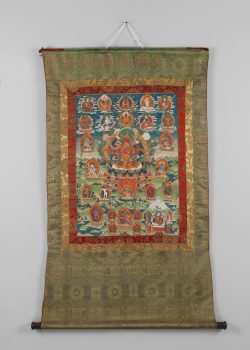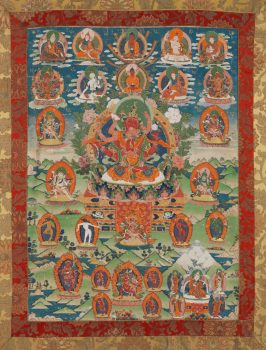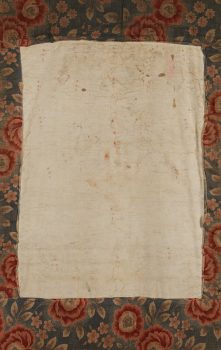Tibet
19th century
A skull cup is an attribute of tantric deities and is usually paired with a curved knife. It can symbolize a mind filled with the bliss of realizing the true nature of reality.
Tibet
19th century



This form of Avalokiteshvara, known as the Ocean of Conquerors (Tibetan: Gyalwa’i gyamtso; Sanskrit: Jinasagara), is worshipped in the Nyingma tradition of Tibetan Buddhism and originates in the terma, “revealed treasure,” teachings of Mindroling Monastery. He appears as a Tantric deity with a consort and is surrounded by his entourage and related deities. Deities belonging to the Lotus Family of Buddha Amitabha are placed along the vertical axis of the painting, and lineage masters are shown in the upper corners. The lower right features the Tibetan deity Tseringma, who is associated with long life and protection. The painting’s composition is clearly laid out and painted in predominantly red and green tones, sparingly supplemented by blues and whites, with gold used for decorative details.
A religious movement that originated in India around the fifth to seventh century with sacred writings and esoteric teachings and practices transmitted from teacher to student through initiation. These remain an important part of Hinduism and Buddhism today.
A contemplative practice in which a person uses concentration and visualization to achieve aims such as transforming the mind and generating feelings of compassion. Techniques include focusing on breathing or visualizing oneself as a deity.
A meditation technique primarily used in tantric practice that involves imagining a deity in one’s mind or imagining oneself becoming a deity and carrying out various activities. Such techniques are intended to help a practitioner transform ordinary perception and achieve enlightened qualities.
Beings who aspire to become fully awakened like the Buddha and are dedicated to helping others on the path to enlightenment.
Today, Tibetans primarily inhabit the Tibetan Plateau, situated between the Himalayan mountain range and the Indian subcontinent to the west, Chinese cultural regions to the east, and Mongolian cultural regions to the northeast. During the 7th to 9th century, Tibetan rulers expanded their empire across Central Asia, and established Buddhism as the state religion.
Get the latest news and stories from the Rubin, plus occasional information on how to support our work.